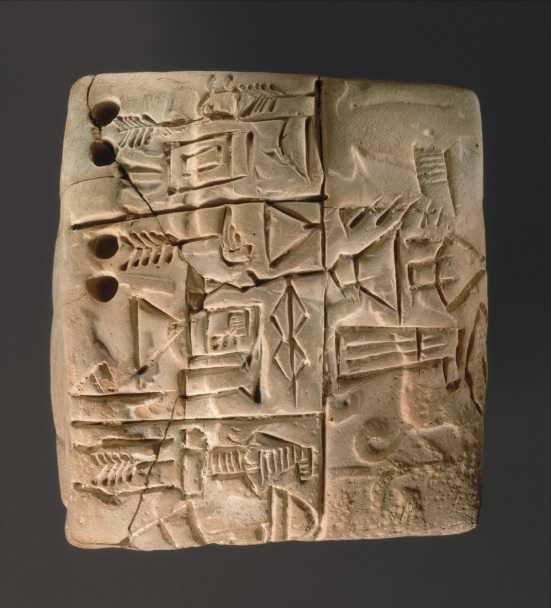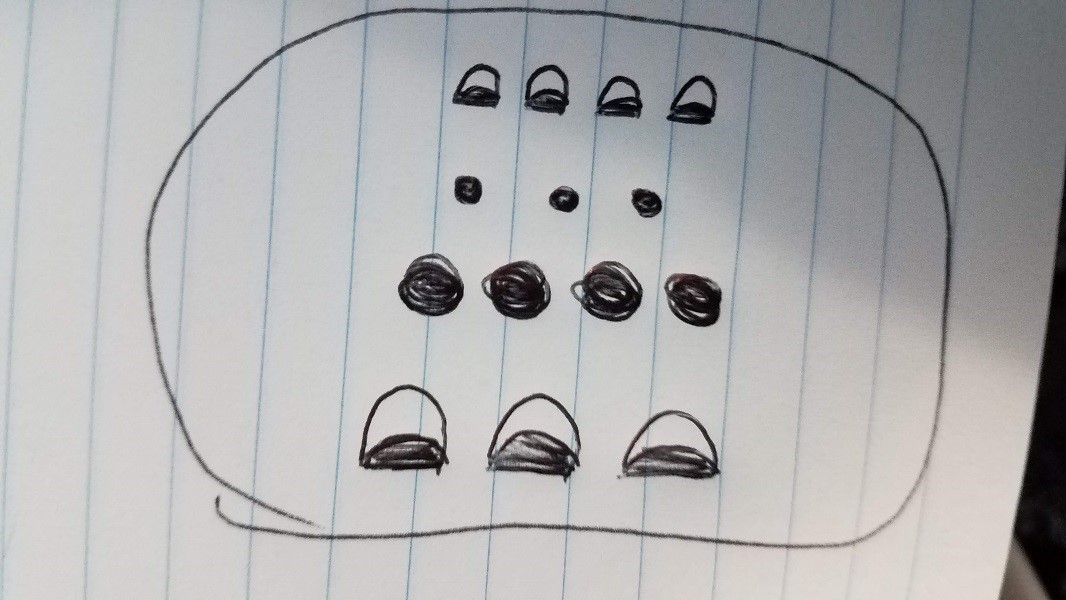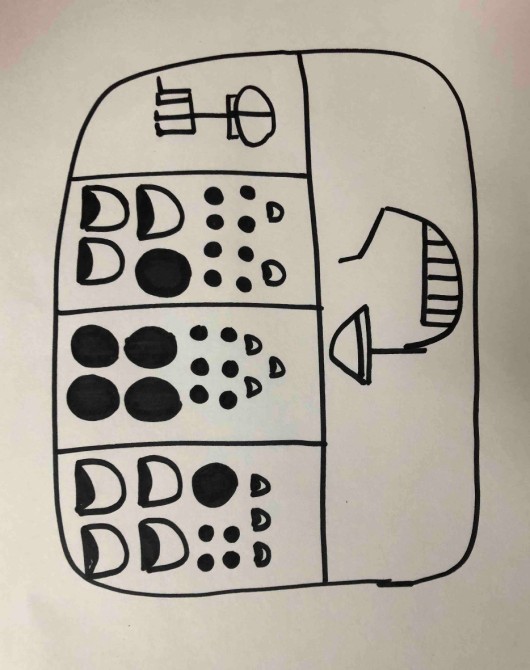Guest post by Professor Bill Maurer
Richard Mattessich (1998) opened his paper in the Accounting Historians’ Journal on 3rd millennium BCE protocuneiform with a quotation from Leonard Bernstein: “The best way to know a thing, is in the context of another discipline” (Bernstein 1976: 3). For two weeks in January, 2019, a class of 114 undergraduate students at the University of California, Irvine, drew made-up protocuneiform tables based on Nissen et al. (1993) after reading Mattessich’s accountant’s perspective on them. They did so as part of a class on “The Future of Money.” The class is still going on, and is being conducted entirely online, except for an end-of-term in person meeting with a panel of payments industry experts and final exam.
Protocuneiform tablets were chosen as the earliest surviving examples of economic transactions utilizing a type of proto-writing that would later develop into the more abstract wedge-shapes of classic cuneiform. The earliest examples date from the late 4th millennium BC (around 3200-3000), from the area of Uruk, and commonly include ‘pictographic’ signs denoting the goods being counted alongside numerals. (You can read more about ‘Proto-Cuneiform’ on the CDLI here and here.)

Split nearly 60%-40% between computer science majors and social science majors, the class read for two weeks on the origins of money—with video lectures in which yours truly tried to disabuse them of the received wisdom of money’s origin in barter, instead to foreground the importance of states’ administrative record keeping. The readings included some essays on tokens by Denise Schmandt-Besserat (including this interview) and parts of James Scott’s book, Against The Grain.
Then the students engaged in a collaborative exercise. Mattessich in hand, they were tasked with drawing their own protocuneiform tablet representing a grain transaction, sending it to another student who would decode it for the next student, who would make a new tablet by adding to the original tablet and sending it to another student, and so on. The online format allowed for this kind of “do something and pass it on” structure: we used an online discussion forum on the Canvas platform that displayed threaded replies so that all the students could see what the others were doing and learn along the way. To make it more manageable, the students were divided into groups of 20-25, so each initial “tablet” went through at least 10 iterations. The whole thing took two weeks, with students responding as each new tablet or new decoding was posted.
Errors crept in along the way. Questions arose as to the placement of symbols on the “tablets” and the difficulty of dealing with a system in which zeros were indicated by empty spaces. Some of the students got a little frustrated. For the computer science students, this was not a typical “lab.” For the social science majors, this was also outside the norm for a homework assignment. Draw an ancient protocuneiform tablet, take a picture of it and post it online for someone else to decode? Pretty weird. But after the first couple of iterations, they really got into it.



I’ll be honest: the point was to have some fun. But this little experiential learning exercise with an ancient writing system brought home a number of lessons I’d hoped it would emphasize.
First, it let them experience the difficulties of encryption and decryption—even with a relatively simple system. Second, it allowed them to reflect on grain and political authority in ancient states, and the bureaucratic power of writing. Some of them even got the point that the power to control writing—specifically the writing of agricultural records—would afford those with power to maintain it, by enforcing systems of tax collection or even to abuse their power by misrecording in order to skim some off the top or to over-tax. Several emphasized “bureaucratic literacy” and the role that unequal access to information would have in an ancient state. (Although, in general, I must admit I was surprised by how trusting the students were: very few brought up the possibility of fraud, for example).
What tripped them up the most? No zeros. One student reported that she had to read the relevant passages of Mattessich out loud “twenty times,” and even “forced” her roommates to help her figure it out, before she could understand how the writing on these tablets worked. What was most impressed in their minds (pardon the pun)? The importance of agriculture in the rise of early states, and the general point about money being a system of transactional record keeping.
In the following weeks we jumped from money’s origins to money’s digitization: we read about the payments industry, how the credit card networks function, and then, yes, Bitcoin and cryptocurrencies. This is where they got the real payoff (again, pardon the pun): having toyed with a transactional record keeping system that did not require a physical token symbolizing “money” passing from hand to hand, the students were better primed to understand cryptocurrency systems based on distributed digital databases of transactional records. In Bitcoin, there is no digital “coin,” no token—just encrypted messages in cryptographically verified chains of custody. Once they got to Bitcoin, they were also able to contrast the decentralized transaction verification system it employs with the relatively centralized systems of ancient Mesopotamia.
As someone who writes and teaches about money a lot, the point that money is a system of record keeping is the most important and the most difficult to convey. We live in a world saturated by what I’ve called “coin consciousness” (Maurer 2019), even as we move into an era where more and more of our monetary transactions are increasingly ethereal. Since at least the 7-6th century BCE when the Lydians minted those famous first coins, most humans have left behind the writing-based monetary universe of the Mesopotamians and allowed material tokens to mask the transactional record keeping that they shorthand for us, even though we know at some level that our money is not “in” the bank but rather in digital “books.” Physical coins and banknotes fool us in that they allow us to imagine “the books” are irrelevant, since value can seemingly move directly from one person to another. This coin consciousness feeds our folk version of the commodity theory of money, the idea that money has to be a thing that is valuable in itself—and, indeed, that such intrinsically valuable things actually exist, absent human meaning-making.
Writing protocuneiform in the context of a class on the future of money helps students appreciate the limits of our common sense perspective on money and value, opens a window into alternative worlds, and sets the stage for a deeper appreciation of money as an accounting device. It also underscores how creditability and accountability go hand in hand with power and inequality, and the centrality to money of writing in record books, whether of clay, bank ledgers, or digital entries in a distributed database.
~ Bill Maurer (Professor of Anthropology and Law, University of California, Irvine)

Special thanks to Melissa Begey, my graduate teaching assistant for this class, to my students, and to Clare Rowan, Denise Schmandt-Besserat, and Philippa Steele for her comments and her willingness to include this post on the CREWS blog.
Further reading:
Bernstein, Leonard. 1976. The Unanswered Question – Six Harvard Lectures (Cambridge, MA: Harvard University Press.
Mattessich, Richard. 1998. Recent insights into Mesopotamian accounting of the 3rd millennium BC: Successor to token accounting. The Accounting Historians Journal 25(1): 1-27.
Maurer, Bill. 2019. Series preface. In A Cultural History of Money, In Antiquity (Volume 1 of A Cultural History of Money). Stefan Krmnicek, ed. London: Bloomsbury, pp. xii-xiv.
Nissen, H.J., Damerow, P. and Englund, R.K.. 1993. Archaic Bookkeeping: Early Writing and Techniques of the Economic Administration in the Ancient Near East. Chicago: University of Chicago Press.


I am trying to discover which ancient- to-medieval era writing systems had no ‘x’ form. Can CREWS enlighten me?
LikeLike
I’m afraid I can’t think of any.
LikeLike